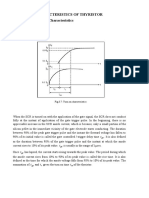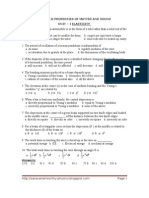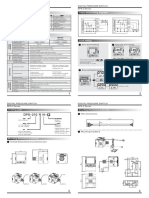Lab Manual - Power Electronics
Uploaded by
prisoner90Lab Manual - Power Electronics
Uploaded by
prisoner90FAKULTI KEJURUTERAAN ELEKTRIK
SUBJECT: ELECTRICAL ENGINEERING LABORATORY II BEKU 3531
FAKULTI KEJURUTERAAN ELEKTRIK UNIVERSITI TEKNIKAL MALAYSIA MELAKA 2012/2013 I
Electrical Engineering Laboratory II Experiment : Power Electronic Circuits
Group Members
:______________________________________ :______________________________________ :______________________________________
Lab Group Program/Section Date Checked By Score Task Prepared by Confirmed by
:______________________________________ :______________________________________ :______________________________________ :______________________________________ : Name Lecturer KJ / TD(A) Signature Date
LAB SHEET
EXPERIMENT : POWER ELECTRONIC CIRCUITS
PAGE: - 1 -
FAKULTI KEJURUTERAAN ELEKTRIK
SUBJECT: ELECTRICAL ENGINEERING LABORATORY II BEKU 3531
EXPERIMENT : POWER ELECTRONIC CIRCUITS LEARNING OUTCOME In the end of the experiment, student should be able to:1) construct power electronic circuits. 2) measure output voltage and current of power electronic circuits. 3) sketch the output voltage and current of power electronic circuits. 4) calculate the performance parameters of power electronic circuits such as average and, rms of voltage and current, output power and total harmonics distortion. EQUIPMENT Instruments 4 channel oscilloscope Lab Volt module Power Diode MOSFET Chopper/Inverter Module 240 Vrms power supply Current/Voltage isolator Resistor and Capacitor load Smoothing inductor Power thyristor
PRELIMINARY LAB WORK/PREPARATION TASK 1. Please find and prepare short notes about the following: a. What made uncontrolled and controlled rectifier are differed? Hint : Find the schematic diagram, type of electronic switches and the output waveform of these two type of rectifiers. b. Related equations use in order to analyze the output of controlled rectifier (Vave, Vrms, Iave, Irms and etc.) for both half wave and full wave topologies. c. The parameter used to evaluate the performance of controlled rectifier together with the equation to represent it. d. Basic information about inverter including the type of inverter (full bridge and half bridge), the schematic of the inverter, type of electronic switches use, basic operation of inverter including the sequence of switching state. e. Shape of output of inverter in term of its voltage and current with R and RL load.
LAB SHEET EXPERIMENT : POWER ELECTRONIC CIRCUITS PAGE: - 2 -
FAKULTI KEJURUTERAAN ELEKTRIK
SUBJECT: ELECTRICAL ENGINEERING LABORATORY II BEKU 3531
f. The parameter used to evaluate the performance of the inverter together with the equation to represent it. g. Method use to improve the quality of output of the inverter including the implementation of Fourier Series analysis to measure the quality of the inverter output. Instruction to student 1. Student should spent not more than six hours (three weeks) on this experiment 2. Notes can be used as the references during lab works session. Important note: Marks on the preliminary preparation task will be included in the rubric criteria. PROCEDURE Halfwave controlled rectifier T1 G AC 240 Vrms 50 Hz Idc RL V 686 dc
Figure 1.1 : Halfwave controlled rectifier
1.
Connect the circuit as shown in Figure 1.1. The value of resistance is set to 686 by connect all the resistance in the resistance module
2.
in parallel.
3.
The value of Idc and Vdc is taken from the oscilloscope by using isolator module. The gate of
thyristor is trigger by using Thyristor Firing Unit.
4.
Turn on the AC supply and set supply to have value of 240 Vrms if the variable AC is used.
LAB SHEET
EXPERIMENT : POWER ELECTRONIC CIRCUITS
PAGE: - 3 -
FAKULTI KEJURUTERAAN ELEKTRIK
SUBJECT: ELECTRICAL ENGINEERING LABORATORY II 5. BEKU 3531
Set the firing angle to have value of 60O. Sketch the triggering signal, output voltage and
current.
6.
Set the firing angle to have a value of 0O. With increment of 20O, increase the firing angle until
it maximum value and record the time delay and value of rms and average of output voltage and current and form your result in one table. 7. Calculate the output DC and AC power base on your equation obtain in pre-lab work at each firing angle and fill the table that has been form before.
8.
Plot the relationship between the firing angle vs AC and DC output power.
Fullwave controlled rectifier Idc G1 T1 AC 240 Vrms 50 Hz T2 T3 RL Vdc 686 G3
G2 T4
G4
Figure 1.2 : Fullwave controlled recifier Figure 1.2 shows the fullwave controlled rectifier. Base on the previous experiment, construct the fullwave controlled rectifier circuit, sketch the output voltage and current waveform at firing angle at 60O and plot the relationship between the firing angle () and the output DC and AC power.
LAB SHEET
EXPERIMENT : POWER ELECTRONIC CIRCUITS
PAGE: - 4 -
FAKULTI KEJURUTERAAN ELEKTRIK
SUBJECT: ELECTRICAL ENGINEERING LABORATORY II BEKU 3531
Fullwave uncontrolled rectifier
Idc D1 AC 240 Vrms 50 Hz D2 D4 D 3 RL Vdc 686
Figure 1.3 : Fullwave uncontrolled recifier By replacing the thyristor module with the power diode module, construct the fullwave uncontrolled rectifier circuit with load of 686. Measure the average and rms of output voltage and current. Compare your result with the calculation method.
LAB SHEET
EXPERIMENT : POWER ELECTRONIC CIRCUITS
PAGE: - 5 -
FAKULTI KEJURUTERAAN ELEKTRIK
SUBJECT: ELECTRICAL ENGINEERING LABORATORY II BEKU 3531
DC to AC converter
G1 + DC IAC VO LOAD VAC G3 Figure 4.3 Full Bridge Inverter Figure 1.4 : :Full Bridge Inverter -
G4
G2
Figure 1.4 shows the full bridge inverter circuit. It use to convert DC power to AC power at certain desired frequency. Two different type of load will be use in this experiment will be use to distinguish the performance of inverter in term of it total harmonic distortion of output voltage and current. The load will be use in this experiment are R load (686 ) and RL load (R = 686, L = 0.8H). Connect the inverter with 240VDC source and set the triggering signal of the power MOSFET so that the output frequency of the inverter is 60 Hz. Record the rms for output voltage and current, sketch the output voltage and current waveform for both different type of load and calculate the total harmonic distortion for both output voltage and current for both type of load. 4VDC cos( n ) 2 n 4VDC 1 = 2 n R 2 + ( L ) 2
Vn,rms =
I n ,rms
(1.1)
cos( n )
(1.2)
THDV =
VO ,rms V1,rms V1,rms I O ,rms I 1,rms I 1,rms
2
100%
(1.3)
THD I =
100%
(1.4)
LAB SHEET
EXPERIMENT : POWER ELECTRONIC CIRCUITS
PAGE: - 6 -
You might also like
- Simulation of Some Power System, Control System and Power Electronics Case Studies Using Matlab and PowerWorld SimulatorFrom EverandSimulation of Some Power System, Control System and Power Electronics Case Studies Using Matlab and PowerWorld SimulatorNo ratings yet
- Power Electronics Lab Experiment-No. 6 Single-Phase Full and Half Wave Controlled SCR Rectifier Aim: To Study and Analyze The Properties and The Characteristics of A Single-PhaseNo ratings yetPower Electronics Lab Experiment-No. 6 Single-Phase Full and Half Wave Controlled SCR Rectifier Aim: To Study and Analyze The Properties and The Characteristics of A Single-Phase6 pages
- Non-Linear Wave Shaping Circuits Clippers AIMNo ratings yetNon-Linear Wave Shaping Circuits Clippers AIM5 pages
- Measurement of Reactive Power of Star and Delta Connected Balanced Loads0% (1)Measurement of Reactive Power of Star and Delta Connected Balanced Loads3 pages
- Aim: To Test Differentiator and Integrator Circuits Using Ua741op-Amp100% (2)Aim: To Test Differentiator and Integrator Circuits Using Ua741op-Amp8 pages
- Experiment No. 3: Characteristics of CMOS InverterNo ratings yetExperiment No. 3: Characteristics of CMOS Inverter6 pages
- Experiment 12 The Universal Motor ObjectiveNo ratings yetExperiment 12 The Universal Motor Objective5 pages
- Observation of Polarity Test of A Single Phase Transformer100% (2)Observation of Polarity Test of A Single Phase Transformer3 pages
- Simulation Exp. 3 Maximum Power Transfer Theorem100% (1)Simulation Exp. 3 Maximum Power Transfer Theorem3 pages
- Design of Regulated Power Supply Using Zener DiodeNo ratings yetDesign of Regulated Power Supply Using Zener Diode7 pages
- Verification of Maximum Power Transfer TheoremNo ratings yetVerification of Maximum Power Transfer Theorem4 pages
- Linear Circuit Analysis Lab Manual BeeeNo ratings yetLinear Circuit Analysis Lab Manual Beee60 pages
- Name of The Experiment: Mathematical Operations Using Op-Amp ObjectiveNo ratings yetName of The Experiment: Mathematical Operations Using Op-Amp Objective2 pages
- Experiment No. 2 Zener Diode ObjectivesNo ratings yetExperiment No. 2 Zener Diode Objectives18 pages
- Expt - 3 - Verification of Reciprocity Theorem For Ac Circuits0% (1)Expt - 3 - Verification of Reciprocity Theorem For Ac Circuits3 pages
- Ell100 Lab Report: Single Phase Transformer B-H LoopNo ratings yetEll100 Lab Report: Single Phase Transformer B-H Loop10 pages
- Unit-3::Half Wave Rectifier, Ripple Factor, Full WaveNo ratings yetUnit-3::Half Wave Rectifier, Ripple Factor, Full Wave12 pages
- Unit-II Rectifiers Filters and Regulators PDFNo ratings yetUnit-II Rectifiers Filters and Regulators PDF48 pages
- Ee3412-Linear and Digital Circuits Laboratory-733621063-Ee 3412-Linear and Digital Integrated Circuits Lab ManualNo ratings yetEe3412-Linear and Digital Circuits Laboratory-733621063-Ee 3412-Linear and Digital Integrated Circuits Lab Manual123 pages
- Parallel Capacitor Inverter With Feedback Diodes100% (1)Parallel Capacitor Inverter With Feedback Diodes9 pages
- Full Wave Bridge Rectifier Circuit Multisim Simulation0% (1)Full Wave Bridge Rectifier Circuit Multisim Simulation3 pages
- "Bridge B2HZ" For The Control of A DC MotorNo ratings yet"Bridge B2HZ" For The Control of A DC Motor16 pages
- P6313 Detecting XRays Ionization ChamberNo ratings yetP6313 Detecting XRays Ionization Chamber4 pages
- Analysis of Fast Transient Voltage Distributions in Transformer Windings Under Different Insulation ConditionsNo ratings yetAnalysis of Fast Transient Voltage Distributions in Transformer Windings Under Different Insulation Conditions8 pages
- Clive A. J. Fletcher-CFD2 - Specific Techniques For Different Flow (1988)No ratings yetClive A. J. Fletcher-CFD2 - Specific Techniques For Different Flow (1988)493 pages
- ELCT 220 Final Exam Study Guide - Solutions PDFNo ratings yetELCT 220 Final Exam Study Guide - Solutions PDF6 pages
- NCERT Solutions For Class 11 Science Maths Chapter 3 - Trigonometric FunctionsNo ratings yetNCERT Solutions For Class 11 Science Maths Chapter 3 - Trigonometric Functions46 pages
- RT8204-DS8204-06 Single Synchronous Buck With LDO ControllerNo ratings yetRT8204-DS8204-06 Single Synchronous Buck With LDO Controller19 pages
- TLE - EPAS - Y2 - Module 4 - Terminating and Connecting of Electrical Wiring and Electronic CircuitNo ratings yetTLE - EPAS - Y2 - Module 4 - Terminating and Connecting of Electrical Wiring and Electronic Circuit47 pages
- Simulation of Some Power System, Control System and Power Electronics Case Studies Using Matlab and PowerWorld SimulatorFrom EverandSimulation of Some Power System, Control System and Power Electronics Case Studies Using Matlab and PowerWorld Simulator
- Power Electronics Lab Experiment-No. 6 Single-Phase Full and Half Wave Controlled SCR Rectifier Aim: To Study and Analyze The Properties and The Characteristics of A Single-PhasePower Electronics Lab Experiment-No. 6 Single-Phase Full and Half Wave Controlled SCR Rectifier Aim: To Study and Analyze The Properties and The Characteristics of A Single-Phase
- Measurement of Reactive Power of Star and Delta Connected Balanced LoadsMeasurement of Reactive Power of Star and Delta Connected Balanced Loads
- Aim: To Test Differentiator and Integrator Circuits Using Ua741op-AmpAim: To Test Differentiator and Integrator Circuits Using Ua741op-Amp
- Experiment No. 3: Characteristics of CMOS InverterExperiment No. 3: Characteristics of CMOS Inverter
- Observation of Polarity Test of A Single Phase TransformerObservation of Polarity Test of A Single Phase Transformer
- Design of Regulated Power Supply Using Zener DiodeDesign of Regulated Power Supply Using Zener Diode
- Name of The Experiment: Mathematical Operations Using Op-Amp ObjectiveName of The Experiment: Mathematical Operations Using Op-Amp Objective
- Expt - 3 - Verification of Reciprocity Theorem For Ac CircuitsExpt - 3 - Verification of Reciprocity Theorem For Ac Circuits
- Ell100 Lab Report: Single Phase Transformer B-H LoopEll100 Lab Report: Single Phase Transformer B-H Loop
- Unit-3::Half Wave Rectifier, Ripple Factor, Full WaveUnit-3::Half Wave Rectifier, Ripple Factor, Full Wave
- Ee3412-Linear and Digital Circuits Laboratory-733621063-Ee 3412-Linear and Digital Integrated Circuits Lab ManualEe3412-Linear and Digital Circuits Laboratory-733621063-Ee 3412-Linear and Digital Integrated Circuits Lab Manual
- Full Wave Bridge Rectifier Circuit Multisim SimulationFull Wave Bridge Rectifier Circuit Multisim Simulation
- Computer Aided Design of Electrical MachinesFrom EverandComputer Aided Design of Electrical Machines
- Analysis of Fast Transient Voltage Distributions in Transformer Windings Under Different Insulation ConditionsAnalysis of Fast Transient Voltage Distributions in Transformer Windings Under Different Insulation Conditions
- Clive A. J. Fletcher-CFD2 - Specific Techniques For Different Flow (1988)Clive A. J. Fletcher-CFD2 - Specific Techniques For Different Flow (1988)
- NCERT Solutions For Class 11 Science Maths Chapter 3 - Trigonometric FunctionsNCERT Solutions For Class 11 Science Maths Chapter 3 - Trigonometric Functions
- RT8204-DS8204-06 Single Synchronous Buck With LDO ControllerRT8204-DS8204-06 Single Synchronous Buck With LDO Controller
- TLE - EPAS - Y2 - Module 4 - Terminating and Connecting of Electrical Wiring and Electronic CircuitTLE - EPAS - Y2 - Module 4 - Terminating and Connecting of Electrical Wiring and Electronic Circuit

























































































